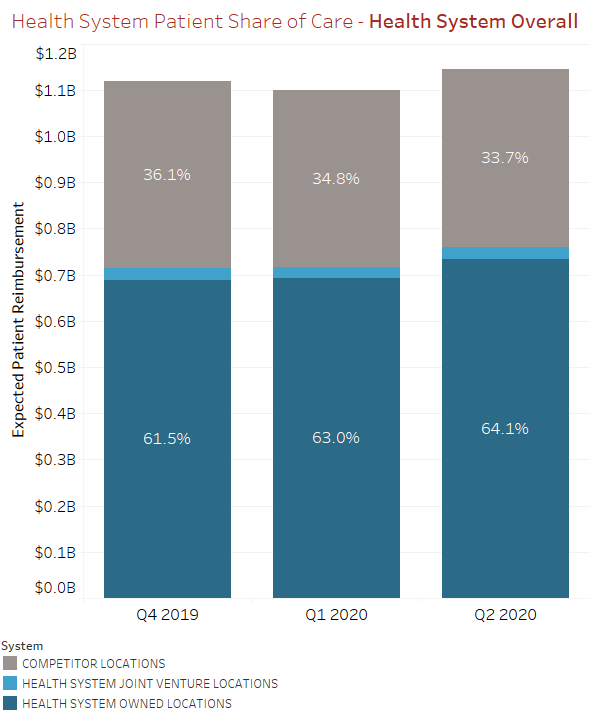OVERVIEW
HSG’s client, a comprehensive health system with a flagship academic medical center, is in a highly competitive market. Though our client has great brand recognition, it was not being fully utilized within the marketplace. With HSG Physician Network Integrity Analytics® and the HSG Patient Share of Care analytic approach, which measures patient loyalty to the health system based on their healthcare utilization spend, the organization was able to measure and then manage patient retention for patients being seen in their primary care practices.
PATIENT RETENTION KEYS TO SUCCESS
The health system’s ability to adequately measure patient retention and leverage the data outputs in manpower planning and marketing efforts throughout the organization have led to their rapid return on investment.
PATIENT LOYALTY MEASUREMENT
HSG’s client had historically only tried to measure patient loyalty to their health system through their health plan population or through their EMR. That approach had limits.
- Biased Data: Data for patients on their health plan was very robust and had insights into competitor activity but was biased. Because of network limits, this patient population was more likely to utilize the client for their healthcare services.
- Robust Data: Conversely, the patient population within the client EMR was more robust but the client was limited to only measuring services that they provided. There was no insight into the competitor activity provided to this patient population or patient self-referrals.
As a result, the client engaged HSG to utilize all-payer claims data to measure and monitor patient loyalty on an ongoing basis through HSG Physician Network Integrity Analytics®. HSG analyzed data using the HSG Patient Share of Care analytic approach to measure and track the utilization of services by patients that were on employed primary care provider panels.
Utilizing our all-payer data set, we were able to overcome both of the prior data issues by 1) capturing data for all patients on their primary care panels, regardless of payer and 2) measuring all healthcare service activity for those patients, regardless of site of service.
DATA LEVERAGE: MARKETING AND MANPOWER PLANNING
Leveraging and operationalizing patient share of care data throughout the health system has not been an easy task. There are two main groups that have produced the most immediate impacts in patient retention: the marketing and strategic planning departments.
- Marketing Department – The marketing department has leveraged this data for their advertising and physician outreach efforts most specifically.
For example, a 2.8% (~$3M) increase in joint replacement volume capture was a direct result of identifying specific geographies in which the health system was underperforming in patient share capture for orthopedic joint replacements compared to other regions where they provided similar services. A handful of zip codes were recognized as greatly underperforming. Advertising and outreach efforts specific to orthopedic joint replacement capabilities were targeted in those areas, resulting in measurable positive returns on the investment.
- Strategic Planning Department – The strategic planning department of the health system, who has responsibilities over medical staff development planning, has been leveraging patient share of care data to support their specialty and primary care recruitment efforts.
For example, a 0.7% (~$2M) increase in gastroenterology share has resulted from physician recruitment opportunities. When looked at very closely, the patient leakage for gastroenterology, was minimal and mainly in regions where gastroenterologists were already very productive with limited capacity for incremental volume. Thus, to increase share, the health system was able to identify a need to recruit an incremental gastroenterologist for a specific market. They were able to recruit quickly and have already been able to see a positive shift in their patient share in that region
CONCLUSION
During the most recent three quarters, the health system has seen patient share increase dramatically from 61.5% to 64.1%. This equates to $25+ million in increased revenue. There was also increased revenue in 4 of 5 priority service lines in patient share. The exception, oncology, has shown only a minor reduction (0.3%) in share. All negative oncology changes were specific to radiation oncology services.

In addition to being able to adequately measure patient loyalty, leveraging the data and exposing it to the right personnel within your organization will lead to great insights where real change can be made.
To learn more about HSG’s approach to patient share of care measurement and get a complementary patient share of care report for patients in your employed network, contact DJ Sullivan.
